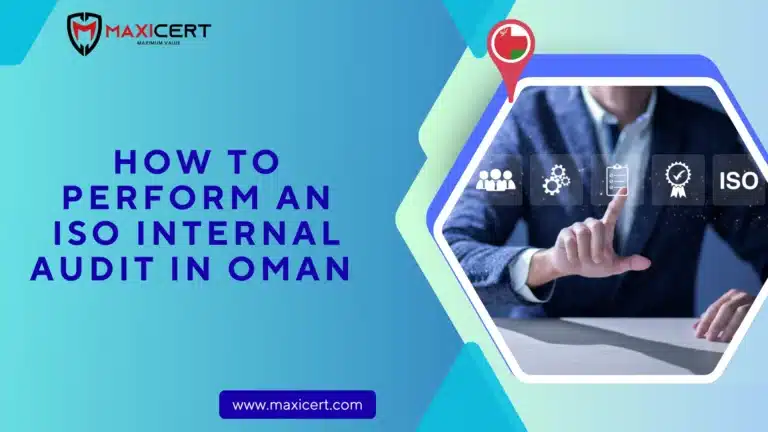How to Perform an ISO Internal Audit in Oman

Introduction
Performing an ISO internal audit is not merely a box-ticking compliance exercise — it’s a valuable means of finding gaps, optimizing performance, and getting ready for external audits. If your company in Oman is ISO-certified or gearing up for it, it is crucial to know the process of internal auditing. This post takes you step by step through the process and offers a downloadable template to enhance your audits.
What is an ISO Internal Audit?
An ISO internal audit is a methodical, impartial assessment of how efficiently your company adheres to the provisions of an individual ISO standard, like ISO 9001 (Quality Management), ISO 14001 (Environmental Management), or ISO 45001 (Occupational Health and Safety).
Purpose:
- Assess the performance of your management system
- Pinpoint gaps or points of improvement
- Prepare for external certification audits
- Spur continual improvement of processes
Difference from External Audits:
- Carried out internally (by staff with training or outsourced consultants)
- Less formal yet still evidence-based
- Improvement-focused, rather than compliance-focused.
Request A Free Quote
Why Internal Audits are Important in Oman
Omani businesses are increasingly under pressure to have strong quality, safety, and environmental standards. Internal audits help ensure that ISO-certified organizations stay compliant and effective.
Internal audits also support alignment with Oman Vision 2040, which emphasizes quality, transparency, and sustainable development across all sectors.
Local Significance:
- Align with national quality drives and Vision 2040
- Comply with sector-specific regulatory requirements (oil & gas, food safety, construction)
- Show accountability and good governance to stakeholders
Government Regulation:
Omani authorities like the Ministry of Commerce, Industry and Investment Promotion tend to require businesses to demonstrate documented proof of consistent internal audits.
ISO Internal Audit Process (Step-by-Step)
1. Define Audit Objectives & Scope
- Identify the purpose of the audit (e.g., routine, pre-certification, follow-up corrective)
- Choose processes, locations, or departments to audit
- Set key objectives (e.g., risk identification, compliance verification, performance improvement)
2. Develop an Audit Plan
- Determine audit dates and frequency
- Engage trained internal auditors or outsource to qualified consultants
- Determine ISO standard clauses applicable to your business
3. Utilize an Internal Audit Checklist
- Develop your checklist using the relevant ISO clauses (e.g., ISO 9001:2015 Clause 9.2)
- Have questions covering policies, procedures, records, and evidence
- Ensure it addresses:
- Context of the organization
- Leadership and planning
- Operational controls
- Monitoring and evaluation
- Context of the organization
[Download Free Internal Audit Template] (insert downloadable link here)
4. Carry Out the Audit
- Interview personnel and witness procedures
- Examine documents and records
- Gather objective facts (photos, logs, reports)
- Document findings: conformities, non-conformities, observations
5. Report Findings & Suggest Action
- Create an audit report summarizing:
- Scope and objectives
- Auditor name(s)
- Key findings and severity
- Recommendations
- Scope and objectives
- Distribute the report to top management
6. Take Corrective Actions
- Review root causes of all non-conformities
- Define corrective action plans with responsible staff and timelines
- Document all actions taken
7. Follow-Up & Continuous Improvement
- Ensure that corrective actions were implemented and effective
- Update audit records and close out any outstanding issues
- Schedule the next cycle of audit
Downloadable ISO Internal Audit Template (Free)
Our editable ISO internal audit template contains:
- Audit planning checklist
- Clause-by-clause audit questions
- Observation and findings section
- Corrective action tracking sheet
How to Use It:
- Select the appropriate ISO standard (9001, 14001, 45001, etc.)
- Modify company details and tailor questions
- Utilize for first-party or supplier audits
[Download the Template Here] (Insert button or link)
For additional best practices, the ISO Auditing Practices Group offers useful guidance on how to conduct effective internal audits.
Common Mistakes in ISO Internal Audits
- Using untrained or biased auditors
- Treating audits as one-off processes
- Not writing down audit results in detail
- Not following up on corrective measures
- Having the same checklist for all ISO standards without modification
Internal Audit for ISO Certification in Oman: Why It's Important
- It’s a mandatory component under Clause 9.2 in the majority of ISO frameworks
- Showcases proactive management and diligence
- Supports audit readiness and improves certification outcomes
- Builds a culture of quality, safety, and sustainability
Get Expert Help with Your ISO Internal Audits
While internal audits can be done in-house, many companies in Oman prefer working with experts to ensure thoroughness and objectivity. Our certified auditors at Maxicert help you:
- Conduct professional ISO audits aligned with your industry
- Train your internal audit team
- Prepare for third-party certification
Conclusion
Conducting ISO internal audits in Oman is essential for maintaining compliance, improving systems, and achieving certification success. With a clear process and the right tools, audits can drive real value across your organization.
Ready to make your ISO internal audit process a breeze?
Download our free ISO audit template or learn about our ISO certification services in Oman. Our professionals are here to walk you through every step to achieve compliance and continuous improvement.

Get In Touch

Get In Touch

Get In Touch
Need A Free Estimate?
Get a free consultation and Checklist to get certified for ISO , HALAL, CE Mark Certification.
FAQ
How frequent should internal audits be performed?
The majority of ISO standards call for audits once a year, however, high-risk sectors might need more regular reviews.
Who is eligible to perform an internal audit?
Internal employees trained in ISO auditing or outside ISO consultants.
Can we adopt the same audit checklist for all ISO standards?
No, every ISO standard is different. The checklist will have to be customized accordingly.
Is internal auditing obligatory for ISO certification in Oman?
Yes, it’s an obligatory clause in most ISO standards and is checked during the certification audits.



